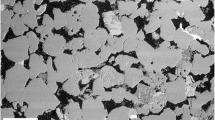A new experimental device for studying the stress sensitivity of capillary pressure is presented. The components of the device are introduced in detail and a protective device for the semipermeable plates is explored. The device offers several advantages. Precise and high drainage pressure are achieved with the use of a pressurized measurement system and high drainage pressure is achieved, while a thermostat maintains a constant temperature throughout the entire process, eliminating the effect of temperature on the stress sensitivity of capillary pressure. The effect of temperature can be studied by varying the parameters of the thermostat. Experiments with a single rock type under varying confining pressures, but with constant drainage pressure are conducted. Based on the analysis of the experimental results, it is established that capillary pressure is affected by the overburden pressure.



Similar content being viewed by others
References
M. K. Dabbous, A. A. Reznik, B. G. Mody, P. F. Fulton, and J. J. Taber, Gas-water capillary pressure in coal at various overburden pressures, Society of Petroleum Engineers J., 261–268 (1976).
H. N. Philip, Pore-throat size in sandstones, tight sandstones and shale, AAPG Bulletin, 3, 329–340 (2009).
Geng-sheng He and Hai Tang, Petrophysics [in Chinese], Science Press, Beijing (2011).
D. Tiab and E. C. Donaldson, 2012. Petrophysics, Elsevier, New York (2012).
V. M. Dobrynin, Effect of overburden pressure on some properties of sandstones, SPE J., 12, 360–366 (1962).
J. B. Walsh and W. F. Brace, The effect of pressure on porosity and the transport properties of rock, J. Geophys. Res., 89 (B11), 9425–9431 (1984).
H. S. Ali, M. A. Al-Marhoun, S. A. Abu-Khamsin, and M. S. Celik, The effect of overburden pressure on relative permeability, Fifth SPE Middle East Oil Show, Mahram, March 7–10, 1987.
N. R. Warpinski and L. W. Teufel, Determination of the effective stress law for permeability and deformation in low-permeability rocks, SPE Formation Evaluation, 7, No. 2, 123–131 (1992).
M. E. Shafiee and A. Kantzas, Investigation on the effect of overburden pressure on vuggy carbonate oil reservoir core properties, Canadian International Petroleum Conference (CIPC), Calgary, Alberta, Canada, June 16–18, 2009.
J. B. Walsh, Effect of pore pressure and confining pressure on fracture permeability, Intern. J. Rock Mechanics and Mining Sciences, 18, 429–435 (1981).
Y. Bernabe, Permeability and Pore Structure of Rocks under Pressure, PhD dissertation, University of Paris (1985).
D. G. Longeron, M. J. Argaud, and J. P. Feraud, Effect of overburden pressure and the nature and microscopic distribution of fluids on electrical properties of rock sample, SPE Formation Evaluation, 6, 194-202 (1989).
N. Mathieu and L. Lyesse, Effective stress concept in unsaturated soils: clarification and validation of a unified framework, Inter. J. Numer. Anal. Methods in Geomechanics, 32,771–801 (2007).
A. Y. Rozhko, Capillary phenomena in partially saturated rocks: theory of effective stress. ARMA 11-146, 45th US Rock Mechanics/Geomechanics Symposium, San Francisco, CA, June 26–29, 2011.
M. A. Sami and A. A. Mohamed, A comparison between capillary and electrical properties of rock samples obtained at ambient conditions and reservoir conditions. SPE 164618, North Africa Technical Conference & Exhibition, Cairo, Egypt, April 15–17, 2013.
G. L. Cherici, G. M. Ciucci, F. Eva, and G. Long, Effect of the overburden pressure on some petrophysical parameters of reservoir rocks, Proc. 7th World Petroleum Conference, Mexico City, 309–330 (1967).
A. O. Ajufo, D. H. Daneshjou, and J. D. Warne, Capillary pressure characteristics at overburden pressure using the centrifuge method, SPE Gas Technology Symposium, Calgary, Alberta, Canada, June 28–30, 1993.
Yi-li Kang, Hao Zhang, Li-jun You, and Qian-gui Li, The response of micro-pore structure parameters of tight sandstones to effective stress changes. Natural Gas Industry, 27, No. 3, 46–48 (2007).
Yun-cheng Wang, Fissured Tight Oil and Gas Reservoirs [in Chinese], Geological Publishing House, Beijing (1992).
M. Saeedi, Modeling and Experiments of Drainage Relative Permeability and Capillary Pressure Functions Using a Centrifuge, MS dissertation, University of Calgary (2007).
O. B. Wilson, The Influence of Porous Plates on Effective Drainage and Imbibition Rates, PhD dissertation, University of Stavanger (2004).
S. A. Elgaghah, D. Tiab, and S. O. Osisanya, A new approach for obtaining J-Function in clean and shaly reservoir using in situ measurements. J. Canadian Petroleum Technology, 40, No. 7, 30–37 (2001).
Author information
Authors and Affiliations
Corresponding author
Additional information
Translated from Khimiya i Tekhnologiya Topliv i Masel, No. 6, pp. 105 – 109, November – December, 2017.
Rights and permissions
About this article
Cite this article
Zhou, J.P., Guo, J.C. & Tao, Z.W. A New Device and New Methods of Studying the Stress Sensitivity of Capillary Pressure. Chem Technol Fuels Oils 53, 976–985 (2018). https://doi.org/10.1007/s10553-018-0887-x
Published:
Issue Date:
DOI: https://doi.org/10.1007/s10553-018-0887-x




